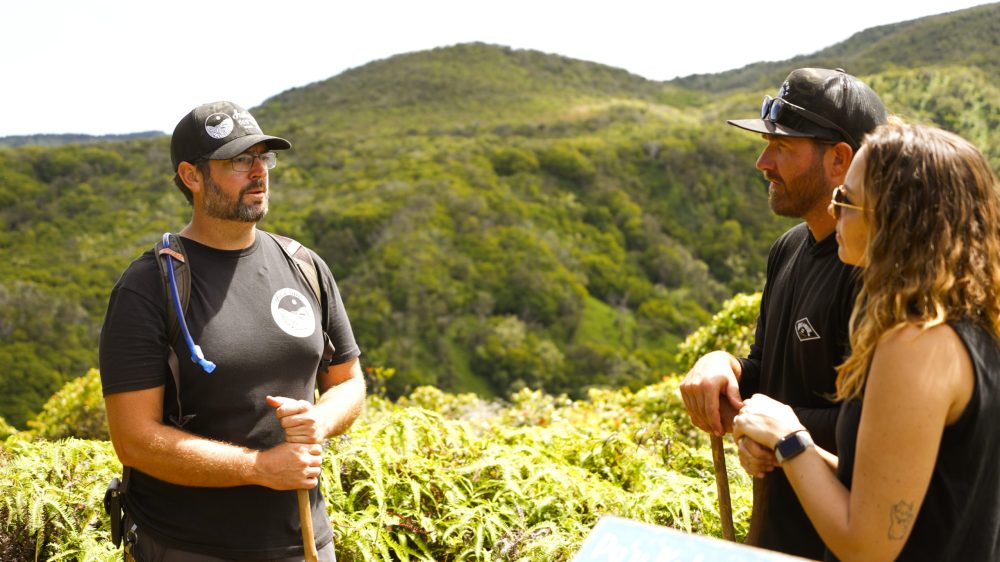Honolua Ridgeline Hike – Putting All the Jigsaw Pieces Together

Maui is pretty unique in that it is an island which it is rich in terms of its geology, geography, botany and biology, and also zoology. One of the problems when on Maui is that there is just so much to take in, to understand about its fascinating ecosystem and to learn about the island’s make-up. To a degree, it is a bit like looking at all the pieces of a jigsaw puzzle randomly laid out and with no final picture to give you an indication of what you are really looking at. So, what’s the solution to this ‘problem’?
A Honolua Ridgeline Hike – ‘learning on the hoof’!
There are numerous books on the flora and fauna, as well as geology of the islands of Hawai’i, but there is a time and a place for burying your head in a book, and now is not that time! Exploring and discovering Maui involves immersing yourself, visually, physically in the beauty of the island, rather than distracting yourself by thumbing through a guide book every two minutes trying to find the information you need.
Instead, why not discover much about the natural history of Maui with your own ‘talking guidebook’, one of the extremely knowledgeable guides who will accompany you on your Honolua Ridgeline hike and who will keep you enthralled and entertained throughout your three-hour ‘journey of discovery.’ Not only that, but you will learn so much about Maui that will help to give you an even greater appreciation of the flora and fauna of the island. Look closely and you may spot a chameleon if it is not too well disguised, but it won’t be indigenous to the island as they were only introduced in the 1970s. There is much to learn!
Maui’s failed attempt at natural pest control
One of the curious things is how a group of islands in the middle of the Pacific has mammals on it. After all, dolphins and green turtles can swim there, and birds can fly there, but the only way for four-legged mammals to get there was by boat. The Polynesian rat was introduced over 1600 years ago, while black and Norwegian rats were introduced by Europeans, as it was commonplace for their first sailing ships that arrived at the islands to be rat infested and it was not long before all the islands, including Maui, became overrun by rats. In the 1800s these rats wrought havoc with the sugar plantations, and it had been heard that in the Caribbean, the rat population there was being controlled by the mongoose, introduced from India.
In the 1870s the mongoose was introduced to the islands of Hawai’i, but things didn’t go quite to plan as the mongoose is active during the day and the rat is active at night, so the two never really encountered each other. Instead, the mongoose chose food that was in abundance, sea turtle eggs and ground-nesting birds’ eggs, which was a bit of a disaster. It was only a combination of the introduction of the domestic cat, many of which contributed to the creation of a feral population of cats, and human trapping that the rat population was finally brought under control. The great thing is you can now get to see mongooses in the wild and yes, for some bizarre reason while the plural of goose is geese, the plural of mongoose is mongooses!
Honolua Ridgeline Guides are a font of information
 You can enjoy a Honolua Ridgeline Trek with a group or, if you prefer, a more personal tour can be booked for up to three of you per guide. Which ever you choose you will have plenty of opportunity to ask questions and to learn all about the nature of the Hawaiian Islands and especially Maui. With a bit of luck they will be able to help you spot such other wildlife as the Nene Goose, the State bird of Hawai’i and which, at one point, was down to just 30 individuals, or a Pueo, the Hawaiian short-eared owl. Just don’t ask your guide why the plural of mongoose is not mongeese!
You can enjoy a Honolua Ridgeline Trek with a group or, if you prefer, a more personal tour can be booked for up to three of you per guide. Which ever you choose you will have plenty of opportunity to ask questions and to learn all about the nature of the Hawaiian Islands and especially Maui. With a bit of luck they will be able to help you spot such other wildlife as the Nene Goose, the State bird of Hawai’i and which, at one point, was down to just 30 individuals, or a Pueo, the Hawaiian short-eared owl. Just don’t ask your guide why the plural of mongoose is not mongeese!
Book your Honolua Ridgeline Hike through Lea Lea
At the end of the tour and as a well-earned treat, you will get to stop at Honolua Bay and enjoy pineapple and other snacks.
We recommend that as you are walking through lots of vegetation you wear clothing that covers your legs and that you do not wear open-toed footwear. Other than that, we recommend you bring your camera or make sure you have your smartphone with you as there will be multiple fabulous photo opportunities along the trail within the Pu’u Kukui Preserve.
The tour lasts approximately three hours and is taken at a leisurely pace, so don’t be put off by the word ‘hike’! You can check here for availability or contact us if you have any questions about the Honolua Ridgeline Hike.
